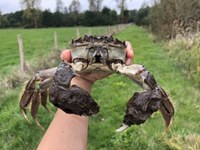Invasive Chinese mitten crabs: New project launched to preserve native ecosystems
Invasive species like the Chinese mitten crab (Eriocheir sinensis), introduced roughly 100 years ago, pose a threat to native ecosystems and can do enormous ecological and economic harm. In its latest report, released just a few weeks ago, the Intergovernmental Science-Policy Platform on Biodiversity and Ecosystem Services (IPBES) once again highlighted the lack of internationally coordinated strategies to combat invasive species. The Flanders Environment Agency (VMM), together with other partners from Belgium, France, Germany and Sweden, have now launched the European funded Interreg North Sea project 'Clancy'. Its goal: to markedly reduce the mitten crab population in European rivers, improving their ecological status in the process.
Back in 1912, when the Chinese mitten crab was first observed in Northern Germany’s Aller River, few expected the oddly hairy crab species to spread so massively here. But today, more than a century later, it’s crystal clear: the species, which was most likely introduced in cargo ships’ ballast water, can now be found in the thousands in nearly every river and ditch along the coasts of the North Sea – from Northern France to Southern Scandinavia. Accordingly, the species has been added to the International Union for Conservation of Nature (IUCN) list of the world’s 100 most dangerous invasive species. Eight institutes have now joined forces to develop strategies for effectively reducing the mitten crab population through the EU-funded Interreg North Sea project 'Clancy'.
New trap design virtually eliminates bycatch
As part of the project, a trap design developed in Belgium, and which has proven to catch the bulk of the crabs, is to be tested internationally. A channel is installed at the bottom of the respective body of water, which the migrating crabs fall into. The channel is designed so that, once they fall in, they can no longer climb back out. As a result, the crabs automatically crawl along pipes that lead to cages on the shore, which can be easily checked and emptied. “Thanks to this design, the trap works with virtually no bycatch, since all animals capable of swimming can escape the channel and only the mitten crab is caught,” explains project staff member Paul van Loon from VMM. “As a result, in the span of four years, roughly two and a half million crabs were caught in just one trap in Belgium.”
"In the span of four years, roughly two and a half million crabs were caught in just one trap in Belgium."
The trap design capitalises on the mitten crab’s unique biology. “Every autumn, the adult crabs, which can measure up to 20 cm from claw to claw, begin migrating toward the coast, sometimes covering several hundred kilometres in the process,” Jonas Schoelynck from the University of Antwerp adds. “They cross streets, climb over levees, and sometimes even appear in people’s yards and basements, until they finally reach the sea. Once there, they mate and die from exhaustion soon after. The next spring, the young mitten crabs begin their migration in the opposite direction. When the new trap is placed in areas with heavy migration traffic, like fish ladders or the mouths of rivers and ditches, many of the crabs can be caught.”
Fewer mitten crabs = healthier waters?
But why go to so much trouble? “The sheer mass of crabs that migrate along the rivers is a huge problem,” says Bastien Chouquet an environmental engineer at Cellule de Suivi du Littoral Normand (France). “Although no-one knows exactly how many there are, various sources indicate that we’re talking about several million. And we can safely assume that these massive numbers also negatively impact aquatic ecosystems.” For example, studies have shown that the appearance of large numbers of mitten crabs corresponds to a decline in freshwater worms, snails, insects and plants. In addition, they damage riverbank structures and clog up water intake points – like those of power plants located near major rivers. The crabs also pose a problem for fishers, as they not only eat their bait, but also damage their nets and traps and gnaw on the fish they’re trying to catch. “Therefore, if we can manage to substantially reduce the mitten crab population, we’ll also be making an important contribution to reaching the targets of the EU’s Water Framework Directive, since it will mean improving the ecological status of our rivers,” says Torsten Heyer from the Institute of Hydraulic Engineering and Technical Hydromechanics, Dresden University of Technology (Germany).
"Studies have shown that the appearance of large numbers of mitten crabs corresponds to a decline in freshwater worms, snails, insects and plants."
Testing the trap at a variety of locations represents an important first step in that direction. At the same time, valuable data will be gathered on the size of the mitten crab population and interrelatedness within it. All results will then contribute to a Europe-wide strategy for effectively combating the mitten crab. “The project is the first step towards combating this invasive species across borders, and ideally, to restoring native waters and waterways to their original state. Needless to say, the mitten crabs caught in the process will have to be killed humanely. There’s also the question of finding a sensible use for the crab,” explains Alfred-Wegner-Institute AWI researcher Björn Suckow, who coordinates public relations for the project. “Consequently, the project will be accompanied by public campaigns, along with information on the steps planned.”
Eight institutes, one goal
In this regard, the project’s collaborative international approach will be critical to achieving a lasting success. Along with Dresden University of Technology and the Alfred Wegener Institute, Flanders Environment Agency, the Province of East Flanders and the University of Antwerp (Belgium), the Groupe d'Etudes des Milieux Estuariens et Littoraux and the Cellule de Suivi du Littoral Normand (France), and the University of Skövde (Sweden) will contribute essential expertise in a range of areas. “Thanks to the Interreg North Sea Programme co-funded by the European Union we are able to actively engage national and regional authorities as well as industries to elaborate an international management system and potentially sensible use for crabs trapped”, says Sonja Leidenberger from University of Skövde. “Ideally, we will inspire other European countries to follow our example”, concludes the project coordinator Nick De Meersman from VMM.
This project receives funding under the Grant Agreement Number 41-2-51-22 from the Interreg North Sea Programme co-funded by the European Union.
 |
|
An impressive adult mitten crab has been trapped. |
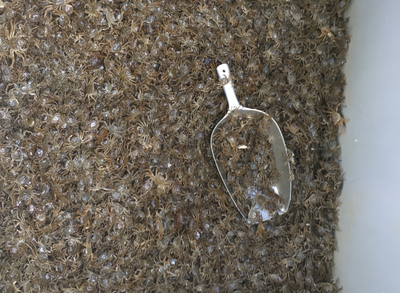 |
|
View into the catch basket. On a 'good day', thousands of young crabs are trapped within 24 hours in the 'Kleine Nete', a small river in Belgium. |
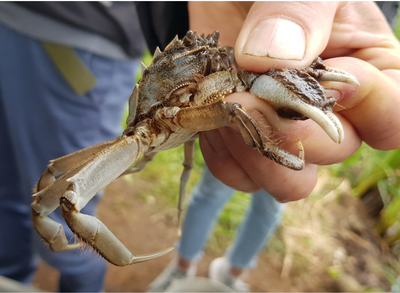 |
|
Grabbed! In the future, mitten crabs will also be trapped in Germany. |
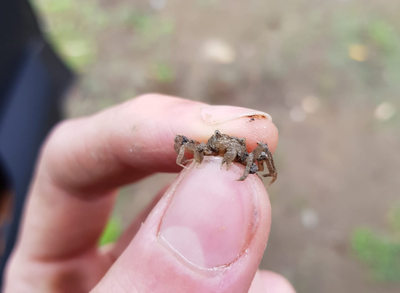 |
|
The juvenile crabs make up the main catch. Here a young mitten crab was caught while migrating upstream. |
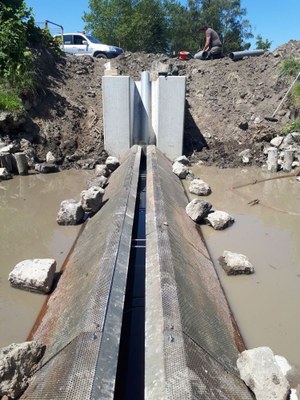 |
|
Construction of the trap in the 'Kleine Nete' river in Belgium. A simple but effective trap construction. |
